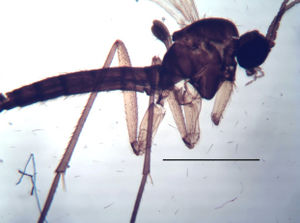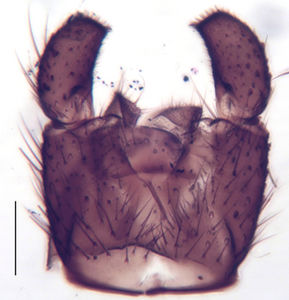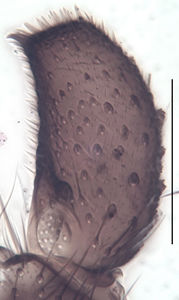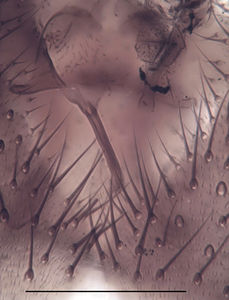Trichosiopsis kleebergi
Ordo: Diptera
Familia: Sciaridae
Genus: Trichosiopsis
Name
Trichosiopsis kleebergi unpublished
Type material
Holotype: ♂, 20.5.–28.5.2015, Malaise trap, leg. Reimann, ZFMK-TIS-2559602 in ZFMK
Type locality
Germany, Saxony, Dresden
Barcoded material
| Stadium | Country | Province | Locality | Habitat | Method | Date | Collector | Collection Number | Collection | Latitude | Longitude | Elevation (m) |
|---|---|---|---|---|---|---|---|---|---|---|---|---|
| 1 ♂ (holotype) | Germany | Saxony | Dresden, Klotzsche | wet meadow | Malaise trap | 20.5.–28.5.2015 | André Reimann | ZFMK-TIS-2559602 | ZFMK | 51.1320 | 13.8190 | 206 |
| 1 ♂ | Germany | Mecklenburg-Vorpommern | Nationalpark Müritz | Car netting | 13.06.2015 | Andreas Kleeberg | ZFMK-TIS-2556370 | ZFMK | 53.4130 | 12.8460 |
Description (male)
Head. Eye bridge 4–5 rows of facets. Antenna unicolour. LW-index of 4th flagellomere 1.8–2.4; neck 0.26–0.36 × segment width; transition of basal part to neck pronounced. Colour of neck unicolour. Antennal setae shorter than segment width; of normal strength; dense. Palpus darkened; of normal length; palpomeres 3. First palpomere of normal shape; with 4–5 setae; with only sparse sensilla. Second palpomere short and oval. Third palpomere as long as first. Thorax. Colour brown. Notum unicolour. Thoracic setae long and strong; black. Posterior pronotum setose. Postpronotal setae 2–3; strong. Mesothoracic sclerites bare. Legs. Colour yellow. Hind coxa of same colour as femora. Setae on front coxa black. Front tibial organ as patch of setae; dark; front tibial organ not bordered. Tibial setae on hind legs normal, shorter than tibial width. Tibial spurs of equal length. Claws untoothed. Wing. Wing slightly darkened; of normal shape. Wing membrane without macrotrichia. Wing venation weak, with faint stM. M-fork of normal shape. R1 ending at or slightly before base of m-fork; posterior veins with macrotrichia; stM mostly with macrotrichia; CuA1 and CuA2 mostly with macrotrichia; bM bare; r-m mostly setose; bM:r-M 0.7–0.85; st-Cu:bM 0.4–0.6; R1:R 1.05–1.3; c:w 0.67–0.77. Halter dark, or darkened; of normal length. Abdomen. Abdominal setae strong; dense; on tergites black; on sternites black. Hypopygium concolour with abdomen; LW-index 0.6–0.8. Base of gonocoxites with strong setae; gonocoxites narrowly separated; inner margin of gonocoxites typically U-shaped; inner membrane of hypopygium scarcely setose; ventral margin of gonocoxite with short setae. Gonostylus elongate; LW-index 2.05–2.3; Inner margin straight, or concave; apex with one obtuse angle. Apical tooth present; without internal structure; of medium strength; LW-Index 1.5–2.5. Awl-like setae normal; present beneath apical tooth. Megasetae absent. Whiplash-hair absent. Tegmen 0.41–0.61 × longer than broad; rectangular with rounded edges; without special features; central process absent. Length of ejaculatory apodeme/hypopygium 22–30 %; base of ejaculatory apodeme present. Field with aedeagal teeth inconspicuous. Measurements. Body size 2.9–3.6 mm. Hind tibia 1.4–1.6 mm. Wing length 2.5–3.2 mm.
Diagnosis
The species is placed in the Trichosiopsis rejecta group and can be distinguished from other, similar species by the combination of the following characters: legs completely yellow with contrasting black setae, strong setae at the base of the gonocoxites, strong and black setae at the fore coxae, gonostylus slender and with an apico-dorsal angle. The species is most similar to Trichosiopsis suecica and can be distinguished by the broader, more clearly angulate gonostylus without fine hairs between the awl-like setae.
DNA Barcoding
The COI sequence is assigned to BIN BOLD:ACX3373 (average distance 1.53%, max. 1.53%, n=2, K2P: 9.81%).
Etymology
The species is named after Andreas Kleeberg, Berlin, the collector of one of the specimens.
Discussion
Both specimens have been collected in the Eastern part of Germany and Tr. kleebergi is not known from other parts of Central or Northern Europe. The morphologically similar species Tr. suecica is on the other hand a strictly Northern European species, This indicates, that many species of Trichosiopsis have a restricted distribution, which may be one reason of the still unknown real species richness of the genus.
Distribution
Germany.
Images
|





